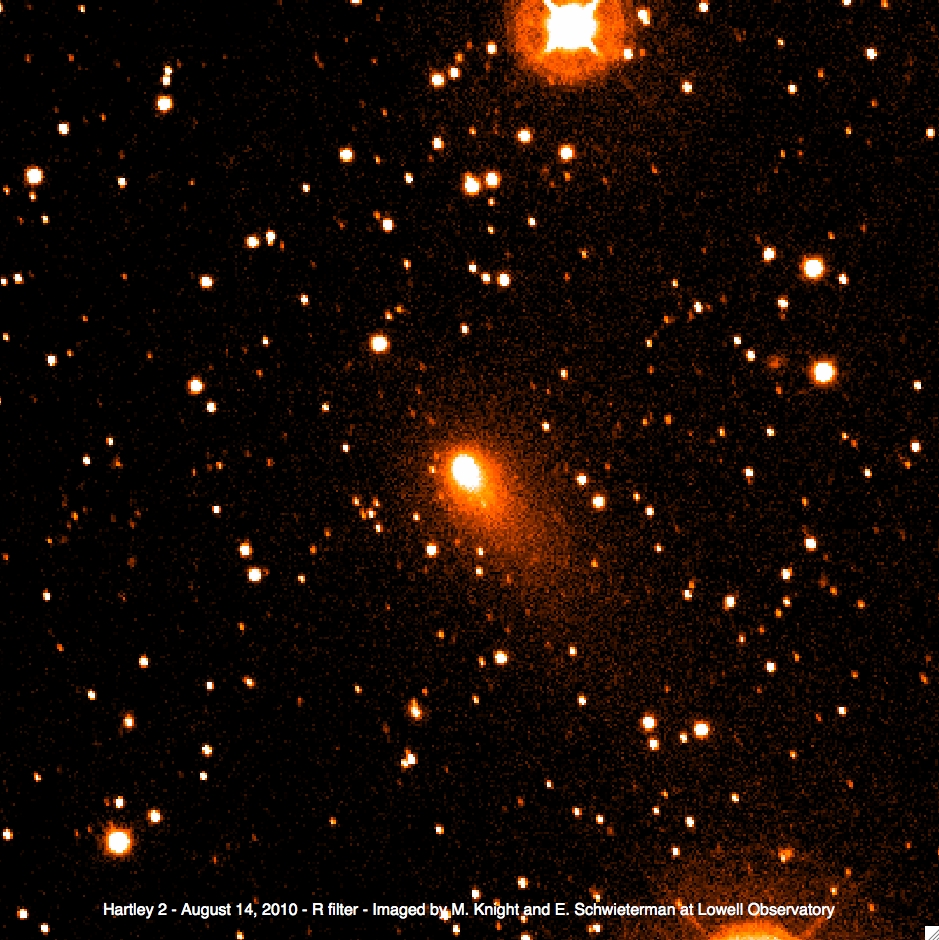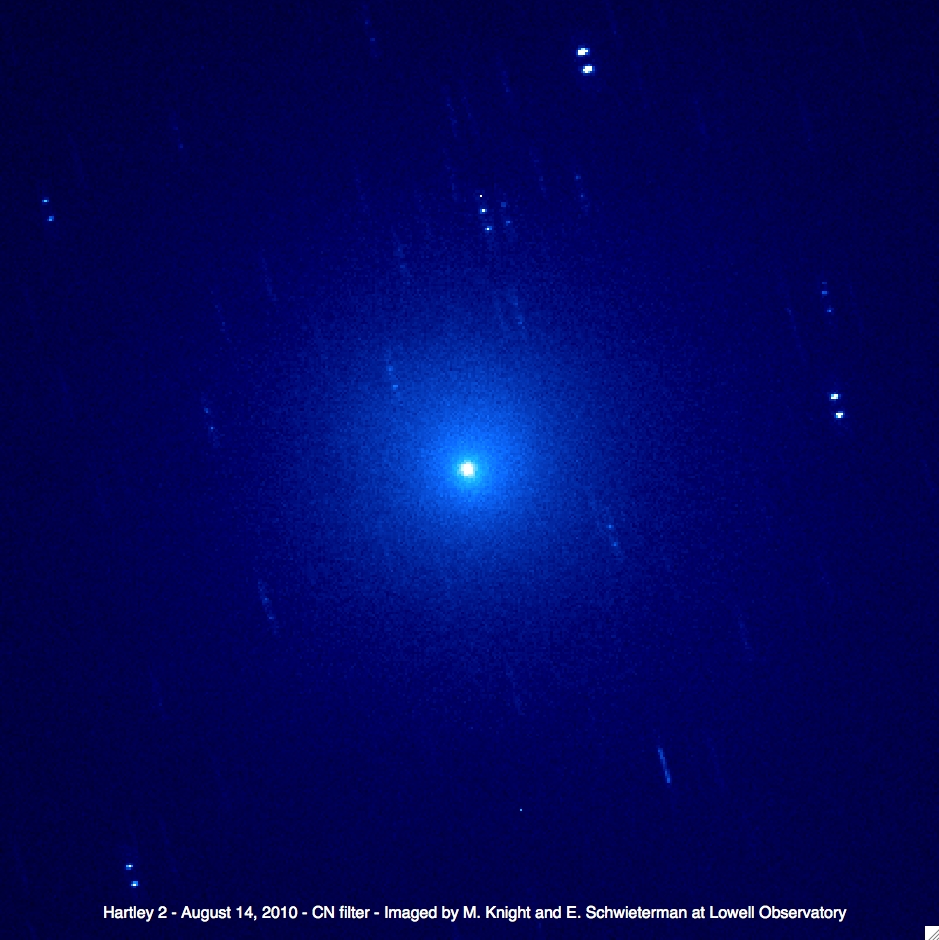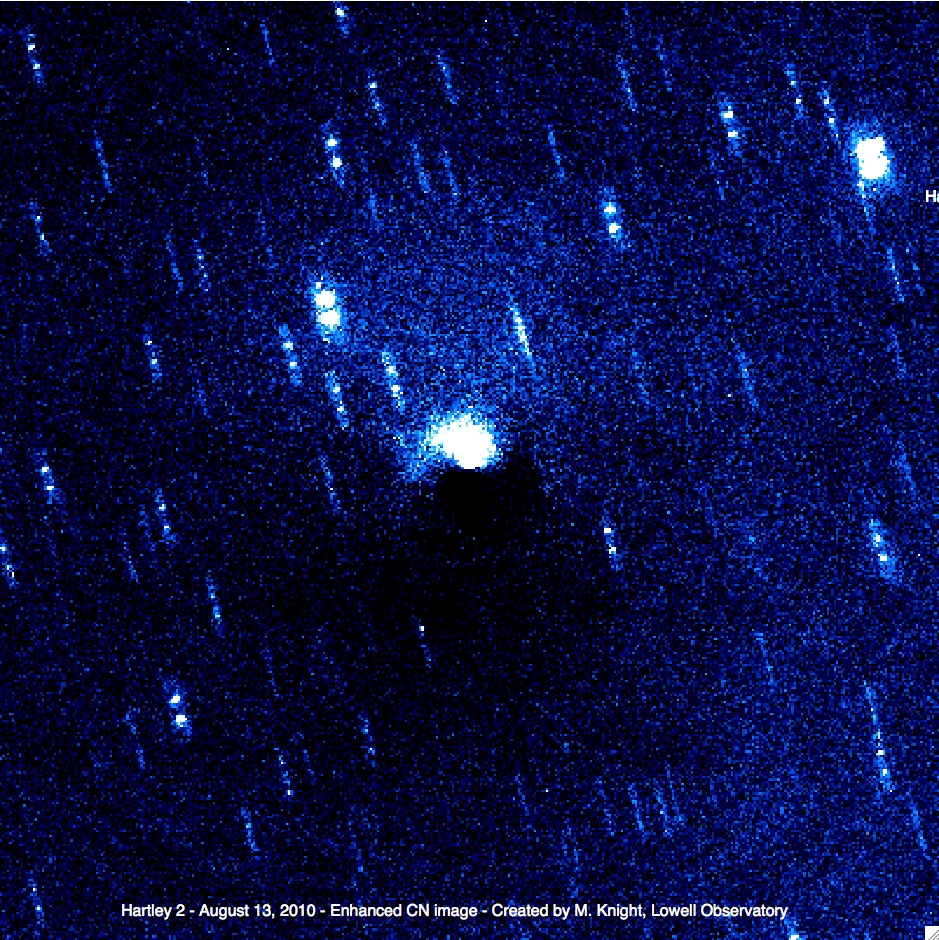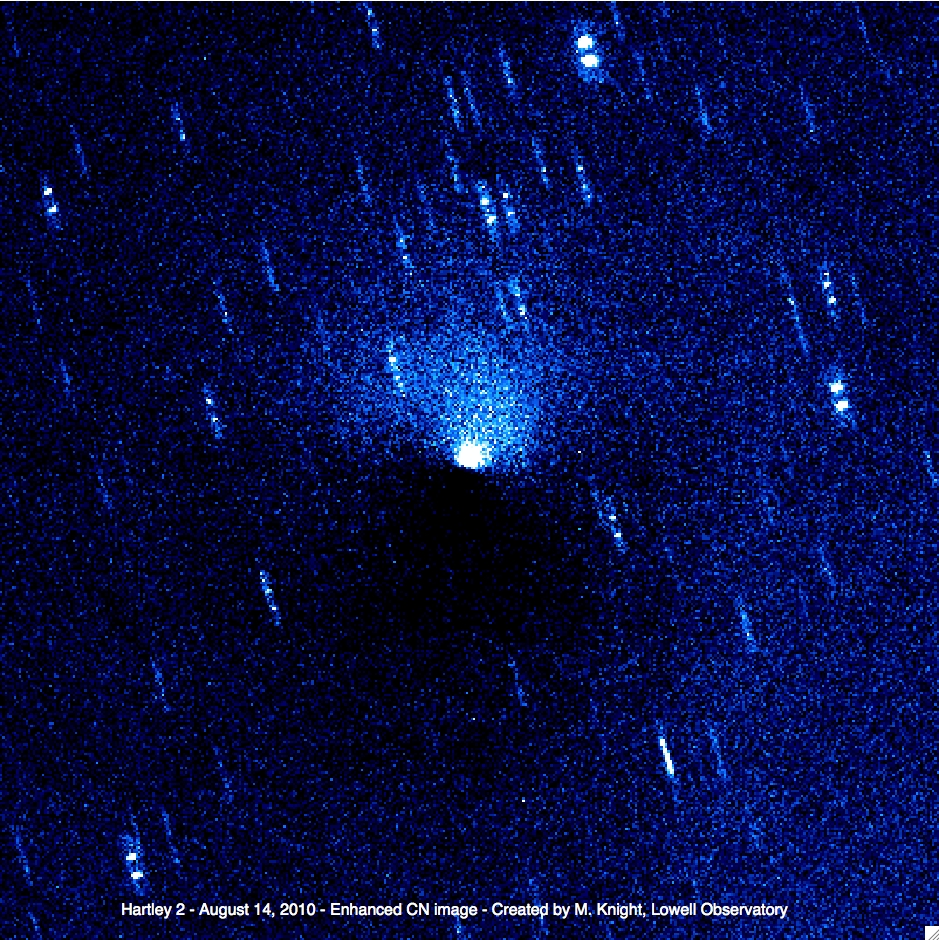Observations of Comet 103P/Hartley 2
at Lowell Observatory
Periodic comet 103P/Hartley 2 was discovered by Malcolm Hartley in 1986. The 2010 apparition is its most favorable since its discovery; it passes within 0.12 AU of the Earth on October 20, briefly achieving naked-eye brightness for observers in dark skies. Hartley 2 reaches perihelion on October 28 and, a week later, will be the target of a flyby by the Deep Impact spacecraft as part of NASA's EPOXI mission. As part of the ongoing comet research at Lowell Observatory, we will be observing Hartley 2 throughout the second half of 2010 using the 42-inch (1.1-m) Hall telescope at Lowell Observatory.
Narrowband Imaging
We first imaged Hartley 2 for one night in July 2010, and obtained five nights of observations in August 2010. We primarily observed the comet with a broadband R filter to observe its dust and with a narrowband CN filter to observe the gas. Like most astronomers who have observed Hartley 2 in the R-band, we found that it has a dust tail, but no other signicant features (left image in Figure 1). However, when observing with the CN filter, we found that Hartley 2's gas morphology was asymmetric, with more activity towards the north (right image in Figure 1).
Raw R and CN Images of Comet 103P/Hartley 2

|

|
|
R
|
CN
|
Figure 1: R (left) and CN (right) images of Comet 103P/Hartley 2 acquired on August 14, 2010 with the
Hall 42-inch (1.1-m) telescope at Lowell Observatory. Each image is constructed of a median of three
consecutive images. This results in the stars appearing as diagonal trails (longer in CN because of the
longer exposure time). Note that false color has been applied and white regions are bright. The images
are approximately 240,000 km on a side. East is to the left and north is up. The position angle of the
Sun is ~22 degrees. Images obtained by M. Knight and E. Schwieterman.
By using image enhancement techniques to accentuate the bright portions of the CN images, we were able to identify a gas "jet" towards the north whose position varies with time (representative images are shown in Figure 2). Over our five night run in August 2010, we identified 15 pairs of images taken at different times which exhibited similar CN morphology. The repetition of these features indicates that Hartley 2 has a rotation period of 16.6 +/- 0.5 hr. This rotation period agrees with that determined by Meech et al. (2009) using 8-10 m telescopes as well as HST when the comet was far from the Sun and a nucleus lightcurve could be measured.
Enhanced CN Images of Comet 103P/Hartley 2

|

|
|
Enhanced CN image near phase = 0.0
|
Enhanced CN image near phase = 0.5
|
Figure 2: Enhanced CN images of 103P/Hartley 2. The left image is from 9:22 UT on August 13, 2010 while
the right image is from 10:27 UT on August 14, 2010. These images are approximately half a rotation cycle apart,
showing the extremes of the coma morphology. Image details and scale are the same as given in Figure 1.
These results appeared on IAUC 9163 and CBET 2418 (subscription required) and are reproduced below. We have upcoming observations planned monthly from September through December 2010. We hope these observations will help us constrain the specifics of our nucleus model, such as the orientation of the comet's rotational pole, the location and size of the active region(s) which causes the CN jet, and the seasonal variability of the comet's activity.
Results published on IAUC 9163 --
M. Knight, E. Schwieterman, and D. Schleicher (Lowell Observatory)
obtained and analyzed extensive CN narrowband images of Comet
103P/Hartley 2 on 5 consecutive nights (2010 Aug 13-17) using
the Hall 42-inch (1.1-m) telescope at Lowell Observatory.
Following the removal of median radial profiles,
an oscillating CN gas feature is seen centered near position angle
350 deg, consistent with a side-on cork-screw jet morphology;
no dust feature other than the tail was visible in R-band images.
Intervals between 15 pairs of matching CN images from various
rotational cycles, coupled with the spacing and the outward
motion of the feature, imply a nucleus rotation period of
16.6+/-0.5 hrs, consistent with the result by Meech et al.
(2009; BAAS 41, 1029). Preliminary modeling suggests a moderate
obliquity of the rotation axis and a mid-latitude source location.
Photometry
We began monitoring Hartley 2 via narrowband photometry in July 2010, and are reporting our results to the EPOXI team to help inform the mission planning. We determined the following production rates for July 12 (r = 1.74 AU): Q (OH; Haser) = 7e26 molecules/s, Q (H2O; vectorial) = 7e26 molecules/s, Q(CN) = 2.0e24 molecules/s, Q(C2) = 1.9e24 molecules/s, Afrho = 20. cm. Our August results were reported on IAUC 9163 and CBET 2418 (subscription required) and are reproduced below.
Results published on IAUC 9163 --
Schleicher adds that he obtained 6 sets of narrowband photometry
of Comet 103P/Hartley 2 on 2010 Aug 11 and 12 (r=1.48-1.47 AU)
using the Hall 42-inch (1.1-m) telescope at Lowell Observatory,
resulting in the following averaged production rates:
log Q(OH) = 27.04; equivalent log Q(water; vectorial) = 27.09;
log Q(NH) = 24.87; log Q(CN) = 24.48; log Q(C2) = 24.56;
log Q(C3) = 23.86; log Afrho(5260A) = 0.93 (cf. IAUC 7342).
There is possible evidence of rotational variability, with values
for CN and C3 lower by 10% on the Aug 12 vs Aug 11 while dust was
lower by ~20%. The implied very low dust-to-gas ratio, based on Afrho
vs Q(OH), matches our measurements from the 1991 and 1997 apparitions.
Based on observations from Hartley 2's 1991 and 1997 apparitions, and the assumption that there are no secular variations between apparitions, a significant seasonal effect exists with peak production taking place several weeks following perihelion. We estimate that the water production at perigee (Oct 20; 8 days prior to perihelion) will be about 2e28 molecules/s, while at the time of the EPOXI encounter (Nov. 4; 7 days following perihelion) we anticipate a value 50% greater, or 3e28 molecules/s.
This research is supported by NASA.
Last Modified 25 August 2010
[Comets overview |
Lowell research]



